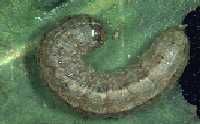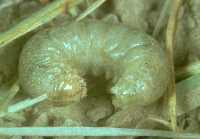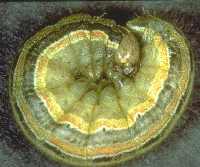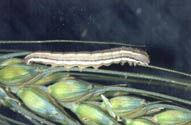by F.B. Peairs 1 (8/2010)
Quick Facts….
- Several species of caterpillars attack wheat in Colorado.
- The most important are the army cutworm, Euxoa auxiliaris, and the pale western cutworm, Agrotis orthogonia.
- Later in the season, the wheat head armyworm, Faronta diffusa, and the armyworm, Pseudaletia unipuncta, can be found infesting wheat and other small grains.
Several species of caterpillars attack wheat in Colorado. The most important of these are the army cutworm, Euxoa auxiliaris, and the pale western cutworm, Agrotis orthogonia, both of which attack the crop in early spring. These can be easily distinguished from each other by the lack of markings on the body of the pale western cutworm (Figures 1 and 2). Later in the season, the wheat head armyworm, Faronta diffusa, and the armyworm, Pseudaletia unipuncta (Figure 3), can be found infesting wheat and other small grains.
Products registered for control of these pests, as well as other control information can be found in the High Plains Integrated Pest Management Guide.
Army Cutworm
 |
| Figure 1: Army cutworm. |
Field biology. The army cutworm has one generation per year. Eggs hatch in the fall following a rainfall. It spends the winter as a partially grown caterpillar. It will feed on warmer days throughout the winter. It feeds more frequently in the spring and develops more rapidly. As daytime temperatures rise, the army cutworm is found under soil clods and other debris during the day. This is a climbing cutworm that feeds above ground during the night and on cloudy days.
After development is complete, it builds a small pupation chamber several inches below the soil surface. Moths emerge in May and June and migrate to higher elevations in the Rocky Mountains to escape high summertime temperatures. These moths are the “millers” that become a household nuisance following outbreaks (see Fact Sheet 5.597, Miller Moths). In late summer and early fall, the moths return to the plains to lay their eggs in wheat fields and other cultivated areas. With sufficient
moisture, eggs hatch and larvae of the next generation start feeding as weather conditions permit.
Host Plants. Army cutworms have a wide host range and feed on most crops grown in Colorado. They feed on just about any green tissue presented to them, although they will show preferences when given a choice. For example, army cutworms have been observed to prefer broadleaf weeds in wheat fields over wheat.
Distribution. Army cutworm is found throughout the western states. Most outbreaks occur in the Great Plains and Rocky Mountain regions of the United States and southern Canada. Army cutworm is found in all agricultural areas of Colorado, although it is mostly a pest of winter grains, sugarbeet and alfalfa.
Scouting and Treatment. Monitor wheat fields periodically during late winter and early spring. Army cutworm is a foliage feeder but usually hides during the day. Larvae can be found under soil clods and surface debris, usually near the base of the plant. Occasionally they are found feeding on cloudy days and during the evening.
Because of the sporadic nature of outbreaks, management is limited to insecticides. Pyrethroid insecticides, as a group, have been the most effective in Colorado State University tests. Army cutworm feeding has the most effect on yield when there is relatively little foliage for them to feed on, which increases the likelihood of damage to the crown. Consider treatment as shown in Table 1.
| Table 1: Guidelines for treatment for army cutworm. | |
| Condition of crop | Treat if larvae exceed |
|---|---|
| Thin or moisture stressed | 2 or more per square foot |
| Healthy | 4 or more per square foot |
Pale Western Cutworm
 |
| Figure 2: Pale western cutworm. |
Field Biology. Adult moths emerge from the soil in late summer and fall. They deposit eggs in loose soil. Eggs usually hatch in late winter. Under some conditions, eggs hatch in the fall and the insect overwinters as a partially grown caterpillar. Hatch may be delayed for up to several months if moisture and temperature conditions are unfavorable. Larvae prefer loose, sandy or dusty soil and are found most easily in the driest parts of the field, such as hilltops. Pale western cutworm is a subterranean cutworm, feeding on stems at the crown. Feeding results in severed stems, and entire fields may be lost in a matter of days. After feeding is complete, larvae move to pupal chambers constructed several inches below the soil surface. Adults start to emerge in August, but most egg laying occurs in September.
Outbreaks are associated with dry conditions in the previous spring. If the preceding May and June had fewer than 10 days on which rainfall exceeded 1/4 inch, expect pale western cutworm populations to increase. If the preceeding May and June had more than 15 days on which rainfall exceeded 1/4 inch, pale western cutworm will almost totally disappear. Rainfall of more than 1/4 inch drives pale western cutworms to the soil surface and exposes them to natural enemies such as birds.
Host Plants. Small grains, corn and a wide variety of other crops are attacked by pale western cutworm. In Colorado, this insect is a major pest of winter grains.
Distribution. Pale western cutworm occurs from the western high plains to the Pacific and from Canada to New Mexico. It has been a sporadic problem in Colorado over the past few years and is potentially one of the most devastating insect pests of wheat known to occur in the state. It is a more consistent problem in the northern plains states and southern Canada.
Scouting and Treatment. Keep in mind that outbreaks tend to follow dry springs (see Field Biology). Also, adult activity can be monitored, using pheromone traps, from mid-August through the end of September. Scouting is more important if high adult activity is detected during the previous summer and fall and weather conditions are dry.
Pale western cutworms tend to concentrate in favorable parts of the field, so it is important to sample the entire field before making any decisions. Start scouting early in the season to avoid severe damage to areas where the larvae concentrate. Leaf feeding, wilted leaves and dead tillers are good signs of cutworm feeding. Dig and sieve the soil from a foot of row (3 inches deep and from row center to row center) to get a count of pale western cutworm larvae per row
foot. Take samples from several parts of the field to get a good picture of the infestation. Spot-treating heavily infested areas can save chemical application costs and prevent the spread of damage.
Because of the sporadic nature of pale western cutworm outbreaks, management is limited to
insecticides. Pyrethroid insecticides, as a group, have been the most effective in Colorado State University tests. Pale western cutworms seem to feed more under dry conditions, so yield relationships are difficult to define. Studies in Wyoming found losses of 5 to 15 percent per larva per foot of row. Consider treatment as shown in Table 2.
| Table 2: Guidelines for treatment for pale western cutworm. | |
| Condition of crop | Treat if larvae exceed |
|---|---|
| Good yield potential | 1 per square foot |
| Low yield potential | 2 per square foot |
Armyworm
 |
| Figure 3: Armyworm. |
Field Biology. The armyworm cannot survive Colorado winters. Instead, armyworm moths migrate into Colorado in early summer. They lay their eggs in rows or clusters on the lower leaves of various grass crops. They prefer dense, grassy vegetation for egglaying. Newly hatched larvae move with a looping (inchworm) action. Larvae feed at night and on cloudy days, and hide under crop debris during sunny periods. One or more generations may occur per year.
Mature larvae are about 1.5 inches in length, smooth-bodied, and dark grey to greenish-black (Figure 3). They have five stripes, three on the back and two on the sides, running the length of the body. While the stripes on the back are variable in color, the stripes on the sides are pale orange with a white outline. The head capsule is remarkable for its “honeycomb” of black markings.
Host Plants. Armyworm feeding is mostly limited to grasses, although it will feed on a number of other plants when starved. In Colorado, armyworm is a pest of corn and spring grains, with only occasional infestations occurring in winter wheat.
Distribution. Armyworm is found east of the Rockies in the United States and Canada. It occurs in all agricultural areas of Colorado.
Scouting and Treatment. Scout for armyworm in field margins, low areas with rank growth or areas of lodged plants. Look for feeding damage, frass (droppings) around base of plant, or plant material that has been severed by armyworm feeding and fallen to the ground. Check for larvae in and under debris around damaged plants and in heads of barley or wheat.
Armyworm outbreaks occur only occasionally because they have many natural enemies that usually prevent the development of economically significant infestations. Because of the sporadic and unpredictable nature of armyworm outbreaks, management is limited to insecticides. Local information on the relative effectiveness of insecticides is not available. Base your product selection on local applicator experience and relative cost.
Consider treating armyworm infestations if all of the following conditions are met:
- larval counts exceed the appropriate level in Table 3 below;
- worms are 0.75 to 1.25 inches long;
- most larvae are not parasitized (look for white eggs behind the head or small brown cocoons attached to the body); and
- leaf feeding or head clipping is evident.
| Table 3: Guidelines for treatment for armyworm. | |
| Crop condition | Treat if larvae exceed |
|---|---|
| Preheading — defoliation in lower leaves | 5 per square foot |
| Headed — head clipping | 2 per square foot |
Wheat Head Armyworm
 |
| Figure 4: Wheat head armyworm (variable in color). |
Field Biology. Little is known about the life history of this insect. It spends the winter as a pupa in the soil. Moths emerge to lay eggs in the spring, and larvae (Figure 4) can be found in wheat in June. First generation larvae feed on the heads of wheat at night and hide near the base of the plant during the day. Damage to grain is similar in appearance to that caused by weevils in stored grain. Pupation occurs again in the soil, and a second moth flight occurs in late August. Colorado
State University light trap catches indicate that two generations per year occur in Colorado.
Host Plants. Wheat head armyworm feeds on a variety of grasses and cereal crops and seems to prefer the heads. Timothy is considered to be a preferred host.
Distribution. Wheat head armyworm is found throughout the United States, as far west as Utah and Arizona. It is found in most wheat-producing areas of Colorado but is considered to be of minor importance.
Scouting and Treatment. Use a sweep net to sample for wheat head armyworm. No chemical control data or economic threshold studies are available for this insect. Infestations often are limited to field margins. If an outbreak occurs, any registered contact insecticide should be effective against this insect.
1 Colorado State University Extension entomologist and professor, bioagricultural sciences and pest management. 9/99. Reviewed 8/2010.
Colorado State University, U.S. Department of Agriculture and Colorado counties cooperating. Extension programs are available to all without discrimination. No endorsement of products mentioned is intended nor is criticism implied of products not mentioned.
Go to top of this page.





